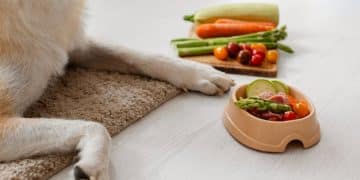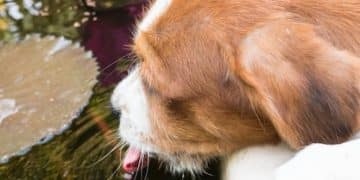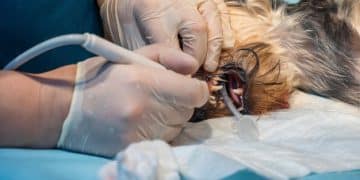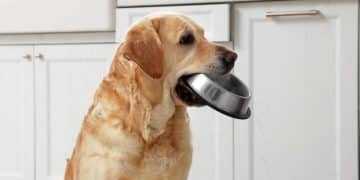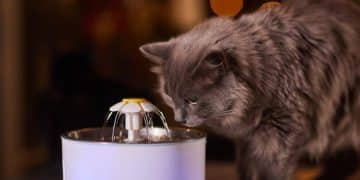Is Your Cat Drinking Enough? Tips to Increase Hydration & Prevent Issues
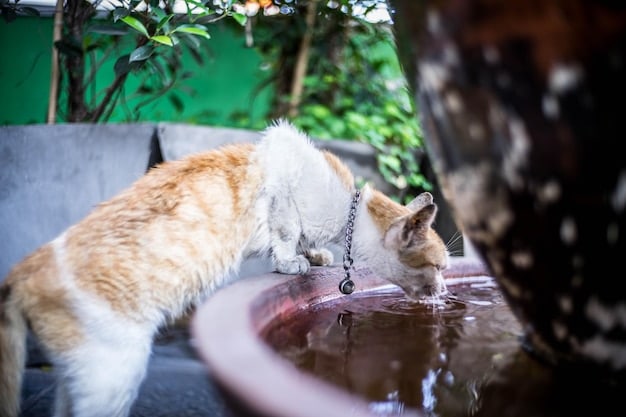
Ensuring your cat drinks enough water is crucial for their health, preventing urinary issues and promoting overall well-being; proven tips include providing fresh water daily, experimenting with different bowls, and incorporating wet food into their diet.
Is your feline friend lapping up enough water each day? Many cat owners underestimate the importance of hydration for their cat’s health. Understanding **is your cat drinking enough water? Proven tips to increase hydration and prevent urinary issues** is crucial for their well-being, and it’s more vital than you might think.
Why Hydration Matters for Your Cat
Hydration plays a pivotal role in your cat’s overall health, influencing everything from kidney function to digestion. Just like humans, cats need water to carry out essential bodily functions.
Adequate hydration helps prevent a range of health issues. Let’s delve into why keeping your cat properly hydrated is paramount.
The Importance of Water for Organ Function
Water is essential for the proper functioning of your cat’s organs. It helps flush out toxins and waste products, preventing them from accumulating and causing harm.
Without enough water, the kidneys have to work harder to concentrate urine, which can lead to kidney disease over time.
Preventing Urinary Tract Problems
One of the most significant benefits of proper hydration is the prevention of urinary tract problems. Cats are prone to developing urinary crystals and stones, which can cause pain and blockages.
Increased water intake dilutes the urine, reducing the concentration of minerals that form these crystals and stones.
- Diluted urine reduces the risk of crystal formation.
- Adequate hydration helps flush out bacteria from the urinary tract.
- Proper hydration reduces inflammation in the bladder.
Ensuring your cat stays well-hydrated is a proactive measure to protect against painful and potentially life-threatening urinary issues.
In conclusion, maintaining proper hydration is not just about quenching thirst; it’s a fundamental aspect of ensuring your cat’s long-term health and well-being. It reduces the risk of severe health problems.
How Much Water Should Your Cat Drink?
Determining the right amount of water for your cat can be tricky, as it varies based on factors like diet, activity level, and overall health. Understanding these factors is essential.
Generally, a cat should drink about 3.5 to 4.5 ounces of water per 5 pounds of body weight daily. Here’s a closer look at the variables.
Factors Influencing Water Intake
Several factors influence how much water your cat needs. Diet is a primary consideration; cats who eat dry food need more water than those who eat wet food.
Active cats and those living in warmer climates will also require more water to stay hydrated.
Calculating Your Cat’s Water Needs
To get a general idea of how much water your cat should be drinking, consider the following:
- Weigh your cat to determine their body weight.
- Estimate the daily water intake based on 3.5 to 4.5 ounces per 5 pounds.
- Monitor water bowl levels daily to gauge their actual intake.
Keep in mind that these are just guidelines. Monitor your cat’s behavior and consult with your vet if you have concerns about their hydration levels.
Overall, knowing how much water your cat should ideally drink daily depends on diverse factors. Regularly monitoring your cat can help you tailor their hydration tactics accordingly.
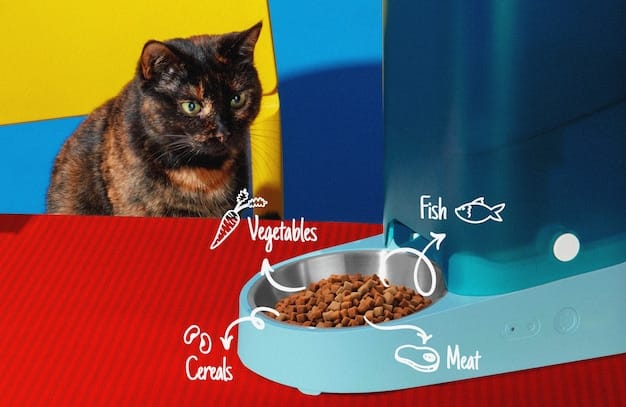
Tips to Encourage Your Cat to Drink More Water
Getting your cat to drink more water can sometimes feel like a challenge. Cats aren’t always naturally inclined to hydrate sufficiently. But there are several strategies you can use to pique their interest in drinking.
From trying different types of bowls to enhancing the water’s appeal, here are practical tips to boost your cat’s water intake.
Experiment with Different Bowls and Placement
Cats can be picky about their water bowls. Some prefer wide, shallow bowls that don’t touch their whiskers. Others may prefer stainless steel or ceramic over plastic, which can harbor bacteria.
Placement also matters. Position water bowls away from food and litter boxes in quiet, accessible areas.
Try a Cat Water Fountain
Many cats are attracted to moving water. A cat water fountain provides a continuous flow of fresh, filtered water that can entice your cat to drink more.
These fountains also help keep the water clean and oxygenated, which can make it more appealing.
- Moving water attracts cats’ attention.
- Fountains keep water fresh and clean.
- They come in various sizes and designs to suit your cat’s preferences.
Add Flavor to the Water
You can make water more enticing by adding a bit of flavor. Try adding a splash of tuna juice or chicken broth to the water bowl.
Ensure that the broth is low in sodium and doesn’t contain any harmful ingredients like garlic or onions.
Ultimately, encouraging your cat to drink more water could require some experimentation, but these approaches can help ensure they get the hydration they need.
Recognizing Signs of Dehydration in Cats
Recognizing the signs of dehydration in cats is crucial for early intervention. Dehydration can lead to severe health problems if left unaddressed.
Being aware of the symptoms allows you to take immediate action and seek veterinary care if necessary. Spotting the signs early can be life-saving.
Physical Symptoms to Watch For
Several physical symptoms can indicate dehydration in cats. These include:
- Lethargy and decreased activity levels.
- Dry gums: Check your cat’s gums; they should be moist, not sticky.
- Sunken eyes indicating reduced fluid levels.
The Skin Turgor Test
The skin turgor test is a simple way to check for dehydration. Gently pinch a small amount of skin on the back of your cat’s neck and release it.
In a well-hydrated cat, the skin will quickly snap back into place. If the skin slowly returns to its original position or tents, it indicates dehydration.
When to Seek Veterinary Care
If you suspect your cat is dehydrated, it’s essential to consult with a veterinarian promptly. Severe dehydration can require intravenous fluids and supportive care.
Do not attempt to rehydrate your cat at home without guidance from a vet, as improper methods can worsen the situation.
Spotting the early signs of dehydration and seeking veterinary assistance can prevent serious health consequences and keep your cat happy and healthy.
The Role of Diet in Hydration
Your cat’s diet plays a significant role in their hydration levels. Understanding the moisture content of different foods can help you ensure your cat stays properly hydrated.
Choosing the right food can be an effective way to boost their water intake without extra effort.
Wet Food vs. Dry Food
Wet food contains a much higher moisture content than dry food, typically around 70-80% moisture compared to dry food’s 10-12%.
Feeding your cat wet food can significantly contribute to their daily hydration needs. Many cats naturally prefer wet food due to its appealing texture and taste.
Incorporating Wet Food into Your Cat’s Diet
If your cat primarily eats dry food, consider incorporating wet food into their diet. You can offer wet food as a meal replacement or as a supplement to their regular dry food ration.
Experiment with different flavors and textures to find what your cat enjoys most. A gradual transition can prevent digestive upset.
Making Homemade Cat Food
For a more controlled approach, you can make homemade cat food with high-moisture ingredients like cooked chicken, broth, and vegetables. Always consult with a veterinary nutritionist for appropriate recipes and nutritional balance.
Homemade food allows you to ensure high moisture content while catering to your cat’s specific dietary needs and preferences.
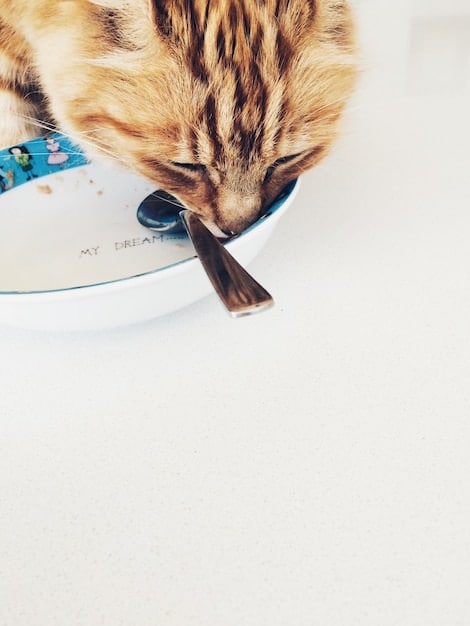
Ultimately, focusing on dietary choices and incorporating moisture-rich options makes hydration easier to manage and seamlessly integrates it into your cat’s daily routine.
Addressing Underlying Health Issues
Sometimes, increased thirst and dehydration can be signs of underlying health issues in cats. Recognizing these potential connections is crucial for timely diagnosis and treatment. Early detection can make a significant difference.
Addressing underlying health conditions can help manage hydration levels and improve overall well-being.
Diabetes and Kidney Disease
Diabetes and kidney disease are two common conditions that can cause increased thirst and dehydration in cats. With diabetes, high blood sugar levels lead to increased urination, causing dehydration.
In kidney disease, the kidneys lose their ability to conserve water, leading to excessive fluid loss.
Hyperthyroidism
Hyperthyroidism is another condition that can cause increased thirst and urination. This hormonal imbalance leads to an increased metabolic rate, which can result in greater fluid intake and output.
Other Potential Causes
Other potential causes of increased thirst and dehydration include urinary tract infections, liver disease, and certain medications. It’s essential to monitor your cat for any signs of illness and consult with your vet if you notice changes in their drinking habits.
- Monitor your cat’s drinking habits for any changes.
- Consult with your vet for prompt diagnosis and treatment.
- Regular check-ups can help catch underlying issues early.
In conclusion, understanding that dehydration could be a symptom of something more severe is essential to ensuring the long-term health of your cat.
| Key Point | Brief Description |
|---|---|
| 💧Hydration Needs | Cats need 3.5-4.5 ounces of water per 5 lbs of body weight daily. |
| 🍲Wet Food | Incorporating wet food boosts hydration due to its high moisture content. |
| ⛲Water Fountain | A fountain can entice cats with fresh, moving water, encouraging them to drink more. |
| 🩺Health Issues | Dehydration can signal underlying conditions like diabetes or kidney disease. Consult your vet. |
Frequently Asked Questions (FAQ)
▼
Check for signs like lethargy, dry gums, and sunken eyes. Perform the skin turgor test by gently pinching the skin on the back of the neck; slow retraction indicates dehydration.
▼
Yes, wet food has a significantly higher moisture content (around 70-80%) compared to dry food (10-12%), making it a better option for increasing your cat’s hydration levels.
▼
Cats can be finicky about their water. Ensure the bowl is clean, made of a preferred material (like ceramic or stainless steel), and placed away from food and litter boxes.
▼
Yes, many cats are attracted to moving water. A water fountain provides fresh, filtered, and flowing water, which can entice your cat to drink more and stay hydrated.
▼
If you suspect your cat is severely dehydrated or showing signs of illness, consult a veterinarian immediately. Prompt veterinary care is essential for proper diagnosis and treatment.
Conclusion
Ensuring your cat drinks enough water is a cornerstone of their health and well-being. By implementing these proven tips and paying close attention to any signs of dehydration, you can help keep your feline friend happy, healthy, and hydrated.
